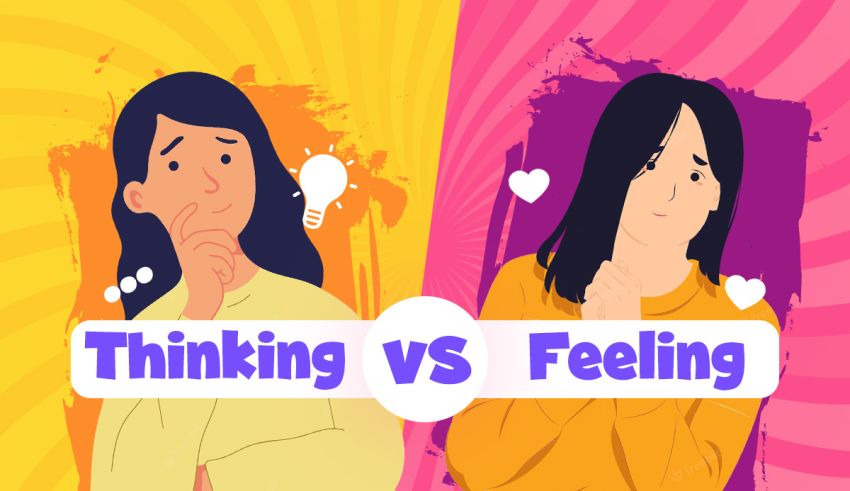Your MBTI judgement axes are revealed by the 20 questions of the thinking vs. feeling exam. It focuses on how you make decisions to determine if you’re a thinker or a feeler.
Finding Your Judging Axes Through a Test of Thinking vs. Feeling
The twenty judgment- and decision-related questions that follow are intended to place you on one of the Thinking (T) or Feeling (F) ends of the spectrum.
Similar to the Realist Vs. Visionary Test, the goal is to identify how logical or emotional your approaches are. Additionally, the quiz reveals your communication style based on your Introverted I and Extroverted (e) dynamics.
Are you more of a Ti-Fe or Te-Fi?
The MBTI theory’s Feeling-Thinking dichotomies correspond to a person’s introversion and extraversion traits. There are two possible pairings: Ti-Fe, which is dominant in introverted thinking and extroverted feeling, and Te-Fi, which is prominent in extroverted thinking and introverted feeling.
Allow the exam to clarify the concept if it sounds complicated. To take part, you don’t need to comprehend any of the Myers-Briggs concepts. The outcomes will further explain the significance of each combination.
Who Qualifies as a Thinker?
A Thinker is someone with reasoning-based judgement axis (also known as Thinking or T). Such a person would make decisions based on information from the outside world and impartial assessments. A Thinker (T), for instance, would treat everyone fairly and with strict adherence to the law.
Who Has Emotions, Exactly?
A person with value-oriented judgement axes is known as a Feeler (sometimes spelled Feeling or F). Such a person would base decisions on own judgments and inner insights. For instance, a Feeler (F) might permit exceptions to the rules or disregard them when doing so would be beneficial.
Questions that the Test Answers
Some use the names’ literal meanings to define the categories. Others contend that it is unscientific to presume that individuals just consider one specific facet of their persona while making decisions.
But both concepts are somewhat incorrect.
The exam aims to dispel three prevalent falsehoods despite the huge stigma surrounding the Thinking vs. Feeling concept.
First, thinkers feel feelers.
Never assume that someone with a T is intellectual or rational while someone with a F is too emotional or illogical. Two distinct decision-making processes that both involve thoughts and emotions are distinguished by the notions of Thinking and Feeling.
The test teaches you that being a Thinker does not automatically make you a philosopher, and vice versa for being a Feeler.
#2. Your judgement axes are unaffected by gender.
There are no gender-specific questions in the test that could skew the findings.
According to the data, there is no connection between evaluating axes and gender identification. Contrary to popular perception, neither men nor women are naturally Thinking or Feeling beings.
3. Neither thinking nor feeling have any particular advantages.
The test findings are not biased in favor of either extreme.
The debate over thinkers vs. feelers in the workplace continues. Despite some claims to the contrary, there is no scientific evidence to support any particular advantages of either type. And the optimal working environment combines each of these factors.
In relation to other facets of life as well, the same is true. There are no benefits to your Fi-Te or Ti-Fe function. However, you can make them into useful facets of your personality that enhance your communication style.
Other Myers-Briggs Dichotomies’ Effects on Test Results
Only one of your preferences for the four MBTI dichotomies is Thinking vs. Feeling. Therefore, identifying your type only based on T or F is incorrect.
You are about to complete a quiz that takes into account all four pairs and produces precise results based on your choices.
The answer to your inquiry may be “Am I a Thinker or a Feeler?” but the outcomes are not. By the time the exam is through, you learn how other facets of your judgement axes, such as introversion or extraversion, may influence your T or F.
What Are a Few Illustrations of the Thinking vs. Feeling Nature?
A manager who thinks maternity and paternity breaks shouldn’t be extended due to a personal circumstance is an example of a Thinking person since they believe regulations should be enforced equally to everyone. However, a supervisor who gives an employee on maternity or paternity leave a few more days off to deal with a family emergency is an example of a feeling person.
Giving examples of T or F personalities is challenging. It’s because, in contrast to distinct activities, judgement axes are concerned with the process of coming to a conclusion. In other words, a Thinker and a Feeler might be seen carrying out the same acts, but with quite different purposes and justifications.
More Important Questions Than “Are You a Thinker or a Feeler?”
Overanalyzing your options might backfire and make it more difficult to distinguish between good and wrong. However, you can think of better inquiries to pose to yourself.
Instead than concentrating on the Thinking vs. Feeling dynamic, consider these useful subjects.
Are my methods for making decisions flawed in any way?
Why bother overthinking your life if you are content with the way you are living it? Of course, it’s a good idea to review your actions from time to time. However, that is unrelated to figuring out if you are a Thinking or a Feeling person.
Both Thinkers and Feelers have one common goal: Making fair decisions. In order to find out what is happening whether your life’s mission has already been fulfilled, you need to take a test.
What should come first for me while making choices?
You are in good shape if you are concerned about everyone’s wellbeing. Being a Thinking or Feeling person has no special benefits. However, making thoughtful decisions could enhance your individuality.
Using Interesting Questions, Let’s Discover Your MBTI Judging Axes.
Twenty questions will help you understand your nature better. The Thinking vs. Feeling exam provides all the information you require to assess your personality based on your judgments.
None of the names or organizations mentioned on this page are connected to QuizExpo. No copyright violation is intended; the exam is an independent effort based on MBTI concepts.





